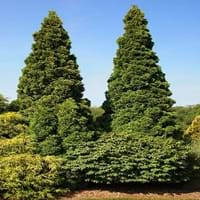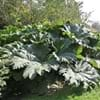Life Span
Perennial
Perennial
Type
Perennial
Needled or Scaled Evergreen
Origin
Hybrid origin
Northeastern United States, Mid-Atlantic United States, Southeastern United States, North-Central United States, Central United States, Canada
Types
Victoria Rhubarb
Colorado Red Rhubarb
Turkish Rhubarb
Not Available
Number of Varieties
Not Available
Habitat
gardens, Grassland, Humid climates, Tropical regions, Urban areas
Dry areas, Lake Sides, riparian zones, Slopes, Upland
USDA Hardiness Zone
5-8
3-7
Sunset Zone
2b, 3a, 3b, 4, 5, 6, 7, 14, 15, 16, 17
A2, A3, H1, H2, 1a, 1b, 2a, 2b, 3a, 3b, 4, 5, 6, 7, 8, 9, 15, 16, 17, 21, 22, 23, 24
Habit
Clump-Forming
Pyramidal
Flower Color
Light Pink
Yellow, Yellow Brown
Flower Color Modifier
Not Available
Bicolor
Fruit Color
Burgundy
Brownish Red, Red
Leaf Color in Spring
Green, Dark Red
Green, Dark Green
Leaf Color in Summer
Green, Dark Red
Green, Dark Green
Leaf Color in Fall
Green, Dark Red
Green, Dark Green
Leaf Color in Winter
Light Green
Green, Dark Green, Brown
Leaf Shape
Compound
Scale-like imbricate
Plant Season
Spring, Summer, Fall
Spring, Summer, Fall, Winter
Sunlight
Full Sun, Partial Sun
Full Sun, Partial Sun
Growth Rate
Medium
Medium
Type of Soil
Clay, Loam
Loam, Sand
The pH of Soil
Acidic, Neutral, Alkaline
Acidic, Neutral
Soil Drainage
Average
Average
Bloom Time
Summer, Late Summer
Spring
Tolerances
Drought
Drought
Where to Plant?
Ground
Ground
How to Plant?
Stem Planting
Seedlings, Stem Cutting
Plant Maintenance
Medium
Medium
Watering Requirements
Do Not over Water, Requires regular watering, Use Mulches to help prevent water loss during hot and windy weather, Water Deeply
Drought Tolerant, Keep the ground moist but not water-logged, Requires regular watering
In Summer
Lots of watering
Lots of watering
In Spring
Moderate
Moderate
In Winter
Average Water
Average Water
Soil pH
Acidic, Neutral, Alkaline
Acidic, Neutral
Soil Type
Clay, Loam
Loam, Sand
Soil Drainage Capacity
Average
Average
Sun Exposure
Full Sun, Partial Sun
Full Sun, Partial Sun
Pruning
Remove damaged leaves, Remove dead branches, Remove dead leaves
Remove damaged leaves, Remove dead branches, Remove dead leaves
Fertilizers
All-Purpose Liquid Fertilizer
All-Purpose Liquid Fertilizer
Pests and Diseases
Red blotch
Citrus leaf miner, Drought, Edema, Gray mold
Plant Tolerance
Drought
Drought
Flower Petal Number
Not Available
Single
Fragrant Bark/Stem
No
Yes
Foliage Texture
Coarse
Medium
Foliage Sheen
Glossy
Glossy
Attracts
Not Available
Birds
Allergy
Skin irritation
Anaphylaxis, Hives, Itchy eyes, Red eyes, Runny nose, Skin rash, sneezing, Watery eyes
Aesthetic Uses
Showy Purposes
Showy Purposes
Beauty Benefits
Not Available
Not Available
Environmental Uses
Air purification
Air purification
Medicinal Uses
Not Available
anti rheumatic, Astringent, Diuretic, Expectorant, Tonic
Part of Plant Used
Whole plant
Bark, extracted oil, Leaves, Twigs
Other Uses
Culinary use, Used as Ornamental plant
Medicinal oil, Used as firewood, Used in herbal medicines, Used in Homeopathy
Used As Indoor Plant
No
No
Used As Outdoor Plant
Yes
Yes
Garden Design
Feature Plant, Mixed Border
Feature Plant, Foundation, Hedges, Mixed Border, Screening, Wind Break
Botanical Name
RHEUM 'Ace of Hearts'
THUJA occidentalis
Common Name
Ace of Hearts Ornamental Rhubarb, Ornamental Rhubarb
northern white cedar, swamp cedar, false white ceda
In Hindi
सजावटी प्रकार का फल
Thuja occidentalis
In German
Ornamental Rhabarber
Abendländischer Lebensbaum
In French
rhubarbe ornementale
Thuya occidental
In Spanish
Ornamental de ruibarbo
Tuya del Canadá
In Greek
καλλωπιστικά Ραβέντι
Thuja occidentalis
In Portuguese
ornamental ruibarbo
Thuja occidentalis
In Polish
ozdobne Rabarbar
Żywotnik_zachodni
In Latin
decentius Rhubarb
Thuja occidentalis
Phylum
Tracheophyta
Tracheophyta
Class
Not Available
Pinopsida
Order
Caryophyllales
Pinales
Family
Polygonaceae
Cupressaceae
Clade
Angiosperms, Core eudicots, Eudicots
Not Available
Tribe
Not Available
Not Available
Subfamily
Not Available
Not Available
Season and Care of Ornamental Rhubarb and White Cedar
Season and care of Ornamental Rhubarb and White Cedar is important to know. While considering everything about Ornamental Rhubarb and White Cedar Care, growing season is an essential factor. Ornamental Rhubarb season is Spring, Summer and Fall and White Cedar season is Spring, Summer and Fall. The type of soil for Ornamental Rhubarb is Clay, Loam and for White Cedar is Loam, Sand while the PH of soil for Ornamental Rhubarb is Acidic, Neutral, Alkaline and for White Cedar is Acidic, Neutral.
Ornamental Rhubarb and White Cedar Physical Information
Ornamental Rhubarb and White Cedar physical information is very important for comparison. Ornamental Rhubarb height is 71.10 cm and width 81.30 cm whereas White Cedar height is 90.00 cm and width 90.00 cm. The color specification of Ornamental Rhubarb and White Cedar are as follows:
Ornamental Rhubarb flower color: Light Pink
Ornamental Rhubarb leaf color: Green and Dark Red
White Cedar flower color: Yellow and Yellow Brown
- White Cedar leaf color: Green and Dark Green
Care of Ornamental Rhubarb and White Cedar
Care of Ornamental Rhubarb and White Cedar include pruning, fertilizers, watering etc. Ornamental Rhubarb pruning is done Remove damaged leaves, Remove dead branches and Remove dead leaves and White Cedar pruning is done Remove damaged leaves, Remove dead branches and Remove dead leaves. In summer Ornamental Rhubarb needs Lots of watering and in winter, it needs Average Water. Whereas, in summer White Cedar needs Lots of watering and in winter, it needs Average Water.





